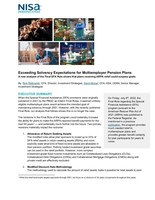-- It is increasingly likely that multiemployer pension plans receiving ARPA relief can achieve and surpass the stated goal of solvency through 2051 --
-- The modified discount rate methodology and allowable investments under the final SFA rule make it possible for multiemployer pensions' total assets to earn an average return that meets or exceeds the discount rate --
-- Plan sponsors and their fiduciaries need to understand the implications for asset allocation and specific fixed income strategies under the final SFA Rule --
ST. LOUIS, Dec. 2, 2022 /PRNewswire/ -- NISA Investment Advisors, LLC ("NISA") released a special report to assist multiemployer pension plans in achieving solvency by navigating the labyrinth of changes under the Special Financial Assistance ("SFA") program's Final Rule. As outlined in a prior NISA posting, the SFA provisions of Sec. 9704 of the American Rescue Plan Act of 2021 ("ARPA") provide a lifeline to many multiemployer plans otherwise facing insolvency in the coming decade.
The new report, "Exceeding Solvency Expectations for Multiemployer Pension Plans," details how the Final Rule allows plans to adopt de-risking and interest rate matching strategies while securely being able to make their benefit payments into the future for decades to come.
David Eichhorn, CFA, CEO and Head of Investment Strategies says, "The ARPA relief represents a great opportunity to provide meaningful pension benefits for years to come for a number of multiemployer pensions. The relief has opened the door to a number of strategies that likely provide greater benefit certainty for participants and better risk management tools for pension plans."
Authors Rick Ratkowski, CFA, Director, Investment Strategies, and David Murad, CFA, ASA, CERA, Senior Manager, Investment Strategies, detail the essential factors for consideration under the Final Rule:
- The Final Rule provides a material increase in the probability that sponsors can make the next 30+ years of benefit payments.
- By shifting to a solvency-focused investment strategy from a more traditional fixed income strategy, plans receiving SFA can increase the probability of making 30 years of benefit payments by at least ~5 to 10%.
- Solvency-focused strategies include cashflow, duration or dollar duration matching a pension's cashflow stream.
- Solvency-focused strategies can increase the amount of benefit payments made and reduce uncertainty through risk management.
- The critical takeaway of managing assets towards the benefits profile and shifting to a solvency-focused strategy provides greater outcome certainty that will hold across plans.
The report also demonstrates that knowing how bad an outcome can be in a downside scenario helps identify a better investment strategy for multiemployer pension plans.
Please visit our website by clicking here to view previous NISA Perspectives posts.
About NISA Investment Advisors, LLC
NISA Investment Advisors, LLC is a registered investment adviser, and manages assets for some of the largest institutional investors in the U.S. The firm is 100% employee-owned and based in St. Louis, Missouri. Client portfolios include investment-grade fixed income, derivative overlay and equity investments. As of September 30, 2022, NISA managed $252 billion in physical assets and $174 billion in derivative notional value in separate account portfolios.
For more information, visit www.nisa.com and see us on LinkedIn.
All investments entail risk including loss of principal; derivatives investments could lose more than the amount invested.
Contact:
Michael Herley for NISA Investment Advisors, LLC
[email protected] or 203-308-1409
SOURCE NISA Investment Advisors, LLC

WANT YOUR COMPANY'S NEWS FEATURED ON PRNEWSWIRE.COM?
Newsrooms &
Influencers
Digital Media
Outlets
Journalists
Opted In






Share this article